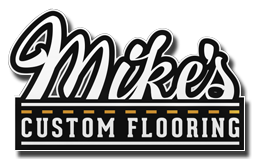Hardwood floors add timeless elegance and warmth to any home, but over time, you might notice the emergence of gaps between the planks. While this might initially be a cause for concern, it’s essential to understand that gaps in hardwood floors are a natural occurrence influenced by various factors. In this blog post, the floor experts at Mikes Custom Flooring will delve into why hardwood floors develop gaps and explore effective solutions to fix them.
What Causes Floor Gapping?
Seasonal Changes: Hardwood floors are hygroscopic, meaning they absorb and release moisture in response to changes in the environment. During humid seasons, the wood absorbs moisture and expands, while in dry seasons, it loses moisture and contracts. This cyclical process can lead to gaps between the planks.
Improper Hardwood Installation: Gaps can result from improper installation techniques. If the wood is not acclimated to the environment before installation or if the installer fails to leave enough expansion space around the perimeter, the floor may develop gaps over time.
Wood Species and Size: Different wood species have varying levels of susceptibility to moisture changes. Additionally, wider planks are more prone to gapping than narrower ones, as they have more room for expansion and contraction.
Low Humidity Levels: In regions with low humidity, especially during winter when heating systems are in use, the air can become dry. This can lead to the contraction of the wood, resulting in gaps between the floorboards.
What Can I Use to Fill Gaps in Hardwood Floors?
Humidification: Maintain a consistent indoor humidity level to minimize the expansion and contraction of the wood. Using a humidifier during dry seasons can prevent excessive moisture loss, reducing the likelihood of gaps.
Proper Hardwood Installation: When installing hardwood floors, ensure that the wood is acclimated to the environment. Leave the recommended expansion gap around the edges of the room, near walls, and around obstacles. This allows the wood to expand without causing gaps.
Fillers and Sealers: For small gaps, consider using wood fillers or sealers. These products are available in various colors to match your floor. Apply them to the gaps, following the manufacturer’s instructions, and sand the surface for a smooth finish.
Hardwood Floor Refinishing: In cases where gaps are more significant or widespread, refinishing the hardwood floor may be necessary. This involves sanding down the surface to remove the existing finish, filling the gaps with wood filler, and applying a new finish to restore the floor’s beauty.
Professional Hardwood Flooring Help: For extensive gaps or if you’re unsure about the best approach, consult with a professional flooring contractor. They can assess the situation, recommend appropriate solutions, and ensure the long-term integrity of your hardwood floors.
Hardwood Floor Installation, Repairs, Refinishing & More in Charles Town & Eastern Panhandle of Berkeley & Jefferson Counties in WV | Winchester & Frederick County | Round Hill & Loudoun County | Berryville & Clarke County | Herndon & Fairfax County VA
Gaps in hardwood floors may be inevitable, but with proper understanding and maintenance, you can mitigate their occurrence and keep your floors looking beautiful for years to come. Whether it’s through humidification, correct installation practices, or utilizing fillers and sealers, taking proactive steps can help you embrace the natural characteristics of hardwood while maintaining a flawless appearance in your home. As always, contact Mikes Custom Flooring for any questions or a free estimate new flooring or repairs. Our expertise friendly service is unmatched. Reach out today to improve your flooring situation.





